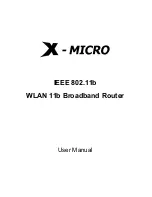
4
1. Functional description
The 10/100BASE-T(X) ports of an SPIDER
xTX(/xFX) represent a terminal connection
for the connected LAN segment. You can
connect single devices or complete network
segments.
1.1 FRAME SWITCHING FUNCTIONS
Store and Forward
All data received by the SPIDER xTX(/xFX)
from the system bus or at the ports are sto-
red and checked for validity. Invalid and
defective frames (> 1.522 byte or CRC error)
as well as fragments (< 64 byte) are discar-
ded. The SPIDER xTX(/xFX) forwards the
valid frames.
Multi address capability
A SPIDER xTX(/xFX) learns all source
addresses per port. Only packets with
– unknown addresses
– addresses learnt at this port
– a multi/broadcast address
in the destination address field are sent to
this port.
A SPIDER xTX(/xFX) learns up to 1,000
addresses. This becomes necessary if more
than one terminal device is connected to
one or more ports. In this way several inde-
pendent subnetworks can be connected to
an SPIDER xTX(/xFX) .
Learnt addresses
An SPIDER xTX(/xFX) monitors the age of
the learned addresses. The SPIDER
xTX(/xFX) deletes address entries from the
address table which exceed a certain age
(300 seconds).
Note:
Restarting deletes the learned
address entries.
Tagging
(IEEE 802.1Q)
The IEEE 802.1 Q standard designates the
VLAN tag to be included in a MAC data
frame for the VLAN and prioritizing func-
tions. The VLAN tag consists of 4 bytes (2
bytes tag protocol identifier TPID, 2 bytes
tag control information TCI). It is inserted
between the source address field and the
type field. Data packets with VLAN tag are
transmitted unchanged by the SPIDER
xTX(/xFX) .
1.2 SPECIFIC FUNCTIONS OF THE
TP/TX INTERFACE
Link control
The SPIDER xTX(/xFX) monitors the connec-
ted TP line segments for short-circuit or
interrupt using regular link test pulses in
accordance with IEEE standard 802.3
10BASE-T/100BASETX. The SPIDER
xTX(/xFX) does not transmit any data to a
TP segment from which it does not receive
a link test pulse.
Note: A non-occupied interface is assessed
as a line interrupt. The TP line to terminal
equipment which is switched off is likewise
assessed as a line interrupt as the de-
energised bus coupler cannot transmit link
test pulses.
Auto polarity exchange
If the receive line pair is incorrectly connec-
ted (RD+ and RD- switched) polarity is auto-
matically reversed.
Autonegotiation
Autonegotiation is a procedure in which the
switch automatically selects the operating
mode of its 10/100 RJ-45 ports. When a
connection is set up for the first time, the
switch detects the speed (10 or 100 Mbit/s)
and the transmission mode of the connec-
ted network (half duplex or full duplex).
Autocrossing
The SPIDER xTX(/xFX) detects the transmit
and receive pairs (MDI, MDI-X). The SPIDER
xTX(/xFX) automatically configures its port
for the correct transmit and receive pins.
Consequently it does not matter whether
you connect devices using a cross-over or
straight cable.
P
x
P
x
P
x
Port 5
Port 4
Port 3
Port 2
Port 1
3-pin
terminal
block
SPIDER 5TX
SPIDER 8TX
SPIDER 4TX/1FX
Port 7
Port 5
Port 3
Port 1
DA/STAT
Port 1
P
10/100
DA/STAT
10/100
DA/STAT
10/100
DA/STAT
10/100
DA/STAT
10/100
DA/STAT
10/100
DA/STAT
10/100
DA/STAT
10/100
DA/STAT
10/100
DA/STAT
Port 8
Port 6
Port 4
Port 2
P
10/100
DA/STAT
10/100
DA/STAT
10/100
DA/STAT
10/100
DA/STAT
P
10/100
DA/STAT
10/100
DA/STAT
10/100
DA/STAT
10/100
DA/STAT
DA/STAT
(Port 1)
3-pin
terminal
block
3-pin
terminal
block
LED display
elements
P
10/100
DA/STAT
LED display
elements
LED display
elements
Port 5
Port 4
Port 3
Port 2
= Power
= Data rate
= Date, Link status
5 ports
10/100BASE-T(X)
RJ45 connectors
autonegotiaton
autopolarity
autocrossing
8 ports
10/100BASE-T(X)
RJ45 connectors
autonegotiaton
autopolarity
autocrossing
4 ports
10/100BASE-T(X)
RJ45 connectors
autonegotiaton
autopolarity
autocrossing
1 port
100BASE-FX
(port 1)
duplex-SC-
connector
full duplex
Fig. 1: Overview interfaces, display elements and controls of the SPIDER xTX(/xFX)

























